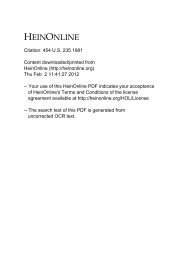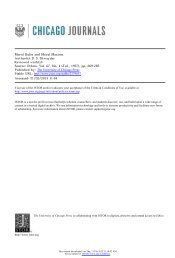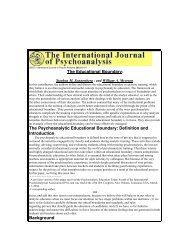A Companion to Linear B - The University of Texas at Austin
A Companion to Linear B - The University of Texas at Austin
A Companion to Linear B - The University of Texas at Austin
Create successful ePaper yourself
Turn your PDF publications into a flip-book with our unique Google optimized e-Paper software.
§12.2.4 SCRIBES, SCRIBAL HANDS AND PALAEOGRAPHY 115<br />
in the his<strong>to</strong>ry <strong>of</strong> Mycenaean society and culture when there was a critical need<br />
for records, i.e., when existing pre-liter<strong>at</strong>e systems <strong>of</strong> control and management<br />
<strong>of</strong> resources, work and exchange were no longer sufficient. 151<br />
We say th<strong>at</strong> the Mycenaeans adopted writing from the Minoans by adapting<br />
<strong>Linear</strong> A so th<strong>at</strong> the new script, <strong>Linear</strong> B, could represent Greek efficiently.<br />
But th<strong>at</strong> is just a manner <strong>of</strong> speaking. It is difficult <strong>to</strong> imagine how<br />
recent illiter<strong>at</strong>es in the first gener<strong>at</strong>ion <strong>of</strong> the use <strong>of</strong> script could adjust it <strong>to</strong><br />
the peculiar fe<strong>at</strong>ures <strong>of</strong> their language. Much more likely, in my opinion, is<br />
th<strong>at</strong> tablet-writers who had used the <strong>Linear</strong> A script, who were wh<strong>at</strong> we conventionally<br />
call ethnic Minoans and who spoke the language or languages th<strong>at</strong><br />
were privileged within Minoan pal<strong>at</strong>ial culture, 152 adapted the <strong>Linear</strong> A sign<br />
reper<strong>to</strong>ries <strong>to</strong> fit the language th<strong>at</strong> would be thenceforth the main language<br />
<strong>of</strong> written communic<strong>at</strong>ion in the Mycenaean st<strong>at</strong>es. <strong>The</strong> earliest records th<strong>at</strong><br />
we possess, the tablets from the Room <strong>of</strong> the Chariot Tablets <strong>at</strong> Knossos, we<br />
must remember, come from the destruction phase <strong>of</strong> the period when the<br />
records were written. This leaves open the possibility th<strong>at</strong> even within the<br />
LM II in<strong>to</strong> LM III A:1 phase, the fe<strong>at</strong>ures th<strong>at</strong> we now know as typical <strong>of</strong><br />
<strong>Linear</strong> B were worked out and eventually fixed over a period <strong>of</strong> years, even<br />
decades.<br />
I have dealt elsewhere 153 with some <strong>of</strong> the differences in form<strong>at</strong>ting and text<br />
arrangement th<strong>at</strong> in my opinion are not significant markers <strong>of</strong> the transition<br />
from Minoan <strong>Linear</strong> A writing <strong>to</strong> Mycenaean <strong>Linear</strong> B writing. Fe<strong>at</strong>ures like<br />
the fuller use <strong>of</strong> rule lines in <strong>Linear</strong> B and the clear separ<strong>at</strong>ion <strong>of</strong> logograms<br />
from the fuller syntactical groups <strong>of</strong> words represented by phonograms are<br />
developments th<strong>at</strong> could have taken place within <strong>Linear</strong> A, had the Minoan<br />
culture ever seen the need <strong>to</strong> write on clay tablets the kinds <strong>of</strong> economic records<br />
the Mycenaeans eventually wrote. 154<br />
Tablet-writers in <strong>Linear</strong> B then would have had a reasonably long period<br />
before the destruction th<strong>at</strong> preserved our earliest tablets, those from the Room<br />
<strong>of</strong> the Chariot Tablets, <strong>to</strong> arrive <strong>at</strong> wh<strong>at</strong> appears <strong>to</strong> be the set reper<strong>to</strong>ry <strong>of</strong><br />
document shapes: page-shaped tablets, clay labels, nodules and leaf-shaped<br />
151<br />
PALAIMA 1987b, 508. PALAIMA 1988, 273-278, <strong>of</strong>fers a complete survey <strong>of</strong> altern<strong>at</strong>ive theories<br />
as <strong>to</strong> when, where and why the <strong>Linear</strong> B script was cre<strong>at</strong>ed. See also PALAIMA 1990b for an<br />
overview <strong>of</strong> writing and administr<strong>at</strong>ion in the Aegean sphere.<br />
152<br />
DUHOUX 1998 and RENFREW 1998 address the language situ<strong>at</strong>ion in Minoan Crete.<br />
153<br />
PALAIMA 1988.<br />
154 For the fe<strong>at</strong>ures <strong>of</strong> <strong>Linear</strong> A tablets in their administr<strong>at</strong>ive contexts, see SCHOEP 2002. Schoep<br />
discusses <strong>Linear</strong> A tablets with rule-lines on pp. 76-77. So far as we can tell, as in <strong>Linear</strong> B,<br />
nowhere in <strong>Linear</strong> A are ideograms imbedded in the syntax <strong>of</strong> phonographically represented<br />
word-groups. <strong>The</strong> reduced context <strong>of</strong> <strong>Linear</strong> A records tends <strong>to</strong> obscure this fact.

















